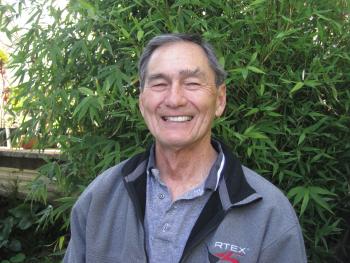Don Dvorak

Cordell Expeditions
This is a compilation of oral history interviews with core team members of Cordell Expeditions, the team of divers that pioneered exploration of Cordell Bank in the late 1970s and 1980s. These individuals' efforts were instrumental in the discovery of Cordell Bank's biological richness, its nomination and designation as a National Marine Sanctuary. The extraordinary biodiversity of this special place was recognized in 1989, when Congress designated Cordell Bank National Marine Sanctuary. Today sanctuary staff work to protect the Cordell Bank region through research, regulations, and education. Interviews were conducted with Cordell Expeditions 'core team' members (those that were significantly involved in the expedition from the beginning to end).
Don Dvorak, a native of Hawaii, has a background that includes service in the Navy and a career in electronics. His professional journey eventually led him to marine technology. Don's interest in underwater photography and the marine field has been a significant aspect of his career. Elaine Dvorak, originally from Washington, D.C., relocated to California, where she became engaged in sailing and commercial fishing. Her involvement with Cordell Expeditions was multifaceted, including navigation, provisioning, cooking, and specimen sorting and preservation. Sue Estey, who grew up in New York and studied biochemistry, developed an interest in the ocean and mountains after moving to Berkeley. Her path led her to diving and underwater photography, particularly within the Cordell Bank National Marine Sanctuary. Together, Don and Elaine Dvorak, along with Sue Estey, have been integral to the exploration and documentation efforts at Cordell Bank, contributing to its designation as a national marine sanctuary.
Scope and Content Note
This interview provides a comprehensive account of the personal backgrounds, motivations, and contributions of Don and Elaine Dvorak and Sue Estey to the Cordell Expeditions in the early 1980s. The interviewees discuss their diverse origins and how their paths converged in the exploration of Cordell Bank. They detail their experiences as divers, highlighting the rarity of women divers, the sense of camaraderie, and the importance of documenting their underwater endeavors through photography. The challenges of underwater photography, including equipment use and the preservation of original images, are also addressed. The interview covers the trio's involvement in the Cordell Bank National Marine Sanctuary, discussing the various aspects of commercial fishing, diving preparations, and the environmental impact of trawling. The interviewees reflect on the significance of their contributions to the sanctuary's preservation and the necessity for ongoing research and conservation. Personal anecdotes about the first dive experiences, encounters with marine life, and the development of relationships within the expeditions enrich the narrative. Technical discussions regarding the practice dives, the use of underwater communication, shark deterrents, and photography equipment provide insight into the logistical aspects of the expeditions. The interview also touches on the operational roles of the crew, including medical care and navigation. The interviewees' shared experiences culminate in a portrayal of the Cordell Bank expeditions as a blend of scientific endeavor, personal growth, and environmental advocacy.
Project Note
Scientific research of California's coast began in the mid 1800's as noted geographer George Davidson and a corps of federal surveyors mapped the coastline of the new state. Cordell Bank was discovered as a shallow shoal by Davidson, but remained a mystery until the1970's when Dr Robert Schmieder, an interested individual, discovered its few relatively shallow contours on a NOAA chart. As a trained scientist by day and an avid recreational diver by weekend, Dr. Schmieder proceeded to find out what was known about Cordell Bank. He found that almost nothing was known about it. Motivated by his own curiosity, and the opportunity to explore what nobody had seen, Bob organized a scientific expedition that would last nearly 10 years. He formed a non-profit group called Cordell Expeditions, who collected specimens, video footage, photographs, and engaged the media to bring awareness to this poorly known marine habitat off the Marin/Sonoma coast. In addition to the intrepid exploration attitude of the team, the depths and dangers were numerous for SCUBA, a method of exploration that has not been attempted on Cordell Bank since. Their extraordinary work was instrumental in the future designation of Cordell Bank and its surrounding waters as a National Marine Sanctuary under NOAA's National Marine Sanctuary Program. The personal experiences of the pioneer divers, many of whom are now approaching advanced age, are unique and irreplaceable elements of the historic expedition that have not been recorded. The body of knowledge of specimens and data collected by Cordell Expeditions is all that historically exists for Cordell Bank and recently has been donated to the California Academy of Sciences (CAS) with the support of the Sanctuary.
Please Note: The oral histories in this collection are protected by copyright and have been created for educational, research and personal use as described by the Fair Use Doctrine in the U.S. Copyright law. Please reach out Voices@noaa.gov to let us know how these interviews are being used in your research, project, exhibit, etc. The Voices staff can help provide other useful resources related to your inquiry.
The NOAA mission is to understand and predict changes in climate, weather, oceans, and coasts, to share that knowledge and information with others, and to conserve and manage coastal and marine ecosystems and resources. The Voices Oral History Archives offers public access to a wide range of accounts, including historical materials that are products of their particular times, and may contain offensive language or negative stereotypes.
Voices Oral History Archives does not verify the accuracy of materials submitted to us. The opinions expressed in the interviews are those of the interviewee only. The interviews here have been made available to the public only after the interviewer has confirmed that they have obtained consent.
